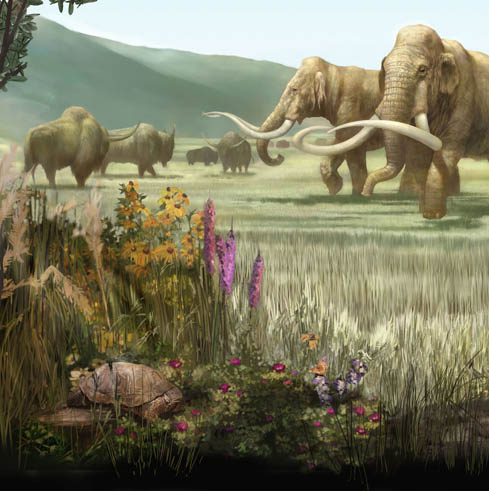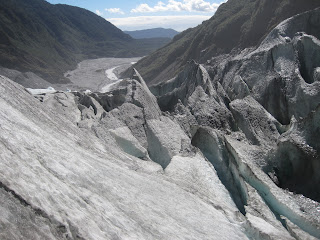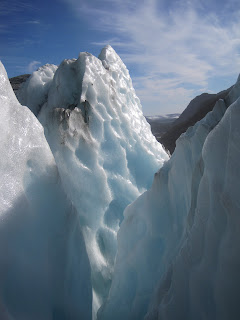So much has happened over the course of geologic time that it seems only right to give each period its due and talk a little bit about the cool geologic and evolutionary events that occurred within it. The first one that I am going to look at is the Pleistocene, which is actually defined as an epoch, a subdivision of a period, and ran from 1.8 million years ago to 11,800 years ago.
 |
| The Cenozoic Era |
While the Pleistocene represents a very, very small portion of geologic time, it was a time of great change that shaped the world of today. What is even more crazy is that I don't mean this in the overused, figurative way that we are all sick of hearing. I literally mean a few gigantic ice sheets actually scraped over the top of the northern hemisphere and changed its entire topography, covering up to 30% of the Earth in ice. Not everywhere was glaciated however, most of Asia, South America and Africa were not glaciated, but even these were heavily influenced during the Pleistocene. However, I am from Canada, and as you can see below most of Canada was run over by an ice sheet a few kilometers thick completely altering the landscape.
 |
|
The causes of the Pleistocence glaciation are likely due to several factors working in concert to induce an ice age. One of these factors are Milankovitch cycles, named for Serbian geophysicist, Milutin Milankovic. Milakovitch cycles describe the periodic changes in the Earth's eccentricity (the shape of the Earth's orbit), which is a 100,000 year cycle, the obliquity or tilt of the Earth's axis which is a 41,000 year cycle and the Earth's precession or the wobble of the Earth as it spins around its axis (imagine how a spinning top can wobble) which occurs on 20,000 year cycle. Sometimes these factors align to bring the Earth further away from the sun, which causes the surface temperature of the Earth to drop.
 |
| Add caption |
Changes in ocean currents are also very important factors in controlling global temperature. Ocean currents are essential for regulating global temperature by transferring warm water from the equator northward to the poles. Changes in the paths of ocean currents due to changes in the positions of the continents or ocean chemistry can also have the opposite effect. Once the pathway of an ocean current changes the warm temperatures that they bring will move with them.
Finally, another factor, one that has been discussed very, very extensively is atmospheric chemistry albeit with the emphasis on global warming rather than on global cooling. The general consensus is that carbon dioxide is to blame for all climate change and damn any other factor. The theory is that high CO2 leads to, or is a symptom of global warming and that low CO2 is a cause or a result of global cooling. Whichever, comes first the chicken or the egg, you cannot deny that CO2 and climate are related.
The ice sheet that covered Canada and much of North America was known as the Laurentide Ice sheet and existed for approximately 70,000 years and was up to 3km thick. In fact, the glacier was so thick and heavy it compressed the land beneath it, which is now only still rebounding back to its original position and will continue to do so for the next few thousand years. There were several periods of advance and retreat during the Pleistocene leading to massive changes in the landscape and the formation of large glacial lakes, rivers, eskers, moraines and other glacial landforms. If you travel in Canada every landform you see, besides a special place called Beringia in the Yukon, has been glaciated and you are looking at a terrain that is only 10,000 years old. Some remnants of the Laurentide Ice sheet still exist today. The Barnes Ice Cap on Baffin Island is one key example and there are several exposures of Laurentide Ice in thaw slumps near Fort McPherson, Northwest Territories. The glacial period ended approximately 10,000 years ago for much the same reasons as it began. Due to a combination of Milakovitch cycles, ocean currents and atmospheric chemistry. One interesting theory that I heard recently is that mammoth farts caused a massive increase in the atmospheric methane concentration, which helped end the Pleistocene glaciation...all I can say is I am glad the planet has had some time to air out.
 |
| Buried ice from the Laurentide Ice Sheet. Once you wash it off it is very tasty (really!) |
The glacial history of the Pleistocene is really cool (pun intended). But, there are other interesting aspects to the Pleistocene besides glaciers. Some of the Earth's most incredible animals lived during the Pleistocene. The Pleistocence was the time of megafauna. Megafauna is a blanket term that refers to many of the animals of the time, which, while very similar to those of today were just way bigger. For example, polar bears of today are very large at 680kg and 3m in length. However, the giant polar bears of the Pleistocene were about 1200kg or more and 3.7m in length. This scaling up of Pleistocene fauna can be seen in giant wolves, beavers, sloths, lions and some birds in North America and in other types of creatures on other continents such as kangaroos, emus and crocodiles in Australia. The reason for the extinction of the Pleistocene megafauna is still a subject of great debate. Some of the arguments are that climate change and the resulting habitat loss led to the extinctions and others believe that over-hunting by humans was a major factor.
 |
| (Karen Carr) |
Check out the comparison of a modern kangaroo leg bone to that of a short faced kangaroo from the Pleistocene:
 |
| (Matt Herod-2009) |
So humans have been around much longer than 10,000 years. What were they doing when everything was covered in ice and the animals were way bigger? Well, there are many theories for the spread of mankind and the colonization of North America. One of the most popular is that a land bridge existed between Russian and Alaska which allowed prehistoric man to cross into North America. Coincidentally, this section of the Yukon and Alaska was the only place not to be covered by the Laurentide Ice sheet. This allowed for the first settlers to make their way south unimpeded by ice. There was also ample hunting of megafauna in the region. In fact, numerous artifacts have been found throughout Beringia that show the evolution of hunting techniques and technology.
 |
| Video showing the shrinking of the Bering Land Bridge |
Alright, that is all for now. Thanks for reading.
Matt












